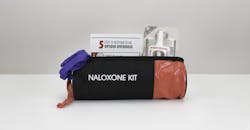With opioid overdoses rising to record numbers, federal agencies and safety organizations in the United States are urging employees to supply their workplaces with naloxone (aka Narcan) nasal spray, which can reverse the effects of an overdose if administered quickly enough.
In Canada, the government of Ontario, under a new law enacted in June, is requiring employers in certain high-risk industries like construction to have these naloxone kits at worksites and train employees on how to use them or face liability for overdoses and potentially steep fines if they do not deploy the kits.
“By ensuring access to life-saving naloxone kits where and when our workers need them, our government is helping to protect more Ontarians struggling with addiction from preventable deaths and taking decisive action to address the challenges of the opioid crisis,” said Michael Tibollo, associate minister of the provincial office of Mental Health and Addictions
The Ontario government reported that approximately 2,500 people died from opioid-related causes between March 2020 and January 2021, and that 30% of these were construction workers.
Compare that to the U.S., where 93,657 people died of drug overdoses in 2021, according to the Centers for Disease Control and Prevention (CDC). Some of these overdoses involved methamphetamine, cocaine and prescription drugs, but most of the deaths (71,238) stemmed from the growing abuse of fentanyl, which is being all too easily smuggled across the US/Mexico border after originating in China.
Although the U.S. government has not yet mandated that naloxone kits be kept in the workplace, safety experts have strongly recommended that employers do so. As early as 2018, the U.S. Surgeon General recommended its use by the general public. “Increasing the availability and targeted distribution of naloxone is a critical component of our efforts to reduce opioid-related overdose deaths,” Jerome Adams said.
By now it has become quite common for police officers, emergency medical services provider and community service workers to carry the naloxone kits, and many lives have been saved as a result.
Less than a year ago, CDC researchers also urged employers acquire the kits. “Overdose deaths occur across the workforce but are more common in some industries. As much as 43% of all drug overdoses deaths at work occurred specifically in the transportation and warehousing, construction, and healthcare and social assistance sectors,” they observed.
“Naloxone is a critical tool for preventing opioid overdose deaths,” the CDC researchers pointed out. “Research has found that overdose deaths decrease in communities that provide naloxone with opportunities for overdose education.”
In 2021, the National Institute for Occupational Safety and Health (NIOSH) produced a video, “Addressing Opioid Overdoses in the Workplaces,” to help employers and workers better understand the risk of opioid overdose and encourage employers to establish a workplace naloxone availability and use program. This video was based on a NIOSH factsheet, Using Naloxone to Reverse Opioid Overdose in the Workplace: Information for Employers and Workers.
The National Safety Council (NSC) also has issued guidelines for employers considering stocking their workplaces with the kits. “Any opioid user—which may include employees, visitors or passersby—is at risk for an opioid overdose,” NSC said.
It stresses that employers should take certain steps before acquiring the kits and starting a workplace program. Policies and procedures should be developed by a core group of representatives, including human resources, safety and health professional employees, and a legal representative, NSC recommends.
Issues the council says employers should consider include liability and other legal issues; recording and documenting trainings and incidents while protecting the privacy of the victims; and defining clear roles and responsibilities for potential responders to a suspected opioid overdose.
Treading Carefully
Attorneys Christine Carey and Cassandra Brumback of the Venable law firm agree. “Don't wait until an employee or customer overdoses on opioids at your business to consider implementing a workplace naloxone program,” they tell employers, urging them to consider what the real likelihood may be that an opioid overdose could occur in their workplace before implementing a naloxone program.
According to Carey and Brumback, other factors to consider include:
- Are you open to the public? Businesses and places that encounter clients or customers may experience an overdose, particularly in retail and service industries.
- Which industry are you in? As was discussed above, the CDC has identified industries with workers who are at higher risk of opioid addiction and have higher opioid overdose death rates. In some cases, these employees may sometimes be prescribed opioids to manage pain arising from slips, trips, falls and heavy workloads, which can lead to misuse and dependence.
- Where is your worksite located? The opioid crisis is severe in most parts of the country. Employers who decide that it isn't that bad in the areas where they operate should reevaluate their decision periodically, because rates are constantly changing, the attorneys advise. In 2021, for example, the states with the highest numbers of overdoses were Alaska, Oregon, Mississippi, Maine and Kansas. The lowest were Arizona, Virginia, Florida, Vermont, Ohio and Pennsylvania. Employers can obtain other solid data regarding opioid use, abuse, overdoses and overdose deaths from the CDC’s website.
- Is there past evidence of drug use on-site? “If there has been evidence of opioid drug use on your workplace grounds in the past (such as finding drugs, needles or other paraphernalia), that is a factor that weighs in favor of implementing a naloxone training program,” note Carey and Brumback.
One of the concerns arising from the prospect of initiating a naloxone program is the issue of potential legal liability. All 50 states and the District of Columbia have some form of naloxone access law, although how those laws are written can vary widely.
“Aspects of naloxone access laws that employers should evaluate include the level of immunity provided to laypersons who administer naloxone, any training/education requirements before a person can administer naloxone, and whether an individual can obtain naloxone without a prescription,” the attorneys explained.
A majority of states and the District of Columbia have enacted Good Samaritan laws that specifically protect laypersons who administer naloxone in good faith in an emergency from both civil and criminal liability. Other states offer only civil immunity, and a few others provide only criminal immunity.
For states like Delaware and South Dakota, which do not have a naloxone-specific Good Samaritan law, the states’ general Good Samaritan laws would still apply to aiding someone suffering from an overdose, Carey and Brumback believe.
They add that when naloxone-related litigation arises, it tends to be brought against healthcare providers for failure to administer the drug. Their law firm’s review of case law did not turn up evidence of a single case that was brought against a Good Samaritan. “Moreover, the theoretical risk of such liability is minimal, considering that side effects from naloxone are very rare and allergic reactions to naloxone are very uncommon,” they said.
Of course, instituting such a program means training of the personnel responsible for administering the naloxone. Several states, including Maryland, require individuals to receive training before administering naloxone, the attorneys add. Local health departments and some health service organizations provide such training free of charge. This training typically covers overdose recognition, safe naloxone administration procedures and potential side effects.
About the Author

David Sparkman
David Sparkman is founding editor of ACWI Advance, the newsletter of the American Chain of Warehouses Inc. He also heads David Sparkman Consulting, a Washington, D.C. area public relations and communications firm. Prior to these he was director of industry relations for the International Warehouse Logistics Association. Sparkman has also been a freelance writer, specializing in logistics and freight transportation. He has served as vice president of communications for the American Moving and Storage Association, director of communications for the National Private Truck Council, and for two decades with American Trucking Associations on its weekly newspaper, Transport Topics.
